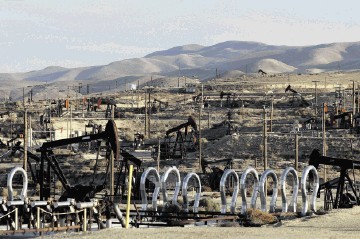
Chesapeake Energy is having its worst year since 1998 after halting dividend payouts, slashing drilling budgets and cutting one of every six employees failed to rescue the energy explorer from the deepest gas-market rout in 16 years.
Chesapeake lost 79% of its market value this year, on pace for 2015’s weakest performance in the Standard & Poor’s 500 Index.
The Oklahoma City-based company’s bonds are trading for as little as 25 cents on the dollar amid heightening concern that Chesapeake will struggle to raise enough cash to avoid defaulting on its debts.
Chief Executive Officer Doug Lawler may be running out of options to revive Chesapeake’s fortunes less than three years after activist investors led by Carl Icahn handpicked him to replace deposed co-founder and CEO Aubrey McClendon.
A complicated debt-reduction measure announced this month with bondholders probably indicates Chesapeake is having trouble raising cash through asset sales, according to Fitch Ratings.
The debt exchange “signals management’s difficulty selling assets in the current stressed hydrocarbon pricing environment” to help close a cash shortfall and cover interest payments, said Dino Kritikos, a credit analyst at Fitch.
Gas fields Chesapeake is trying to sell are losing their luster since prices fell to levels not seen since 1999, he said.
The oil and gas industry has been in free fall since late 2014 as weakening demand growth exacerbated a glut of supply from US shale fields, OPEC and Russia.
Drillers and their suppliers have fired more than 200,000 workers, halted dividends and postponed their costliest, riskiest ventures to slow the drain of precious cash reserves.
Investors have battered the sector, wiping out $364 billion in the collective market value of the 40 energy companies in the S&P 500 this year.
Chesapeake, which until 2010 was the No. 1 US gas producer, entered the industry downturn in an already-weakened state after years of overspending, heavy borrowing and complex financial arrangements that were a hallmark of McClendon’s quarter-century reign at the company.
Lawler’s task upon taking over in mid-2013 has been to cut costs, simplify the corporate structure and shift Chesapeake into higher-profit crude production and away from gas.
That evolution has been stunted as collapsing prices for both gas and oil wiped out cash to expand drilling and boost crude output.
As of September 30, more than 80% of Chesapeake’s overall production was still comprised of gas and byproducts such as propane.
Lawler, the former deepwater exploration chief at Anadarko Petroleum Corp declined through spokesman Gordon Pennoyer to be interviewed for this article.
Chesapeake has hired restructuring adviser Evercore Partners to help reorganise its debts, according to a person with knowledge of the matter.
The company is looking to shore up its liquidity through bond exchanges or an asset sale, said the person, who asked not to be named because the hiring isn’t public.
Chesapeake fell 8.5% to $4.07 at the close in New York on Monday, after earlier dropping 10%.
The shares slumped to $3.72 on December 17, the lowest closing price since May 2000. If this year’s decline holds through the end of this week, it’ll be the biggest annual drop since 1998, when Chesapeake tumbled 88 percent.
The company’s 5.75% bonds maturing in March 2023 fell 10% to trade for 26.125 cents on the dollar on Monday. The yield topped 33%, according to Trace, the bond-price reporting system of the Financial Industry Regulatory Authority. The notes traded at a record low of 24 cents on the dollar to yield 35.5% on December 18.